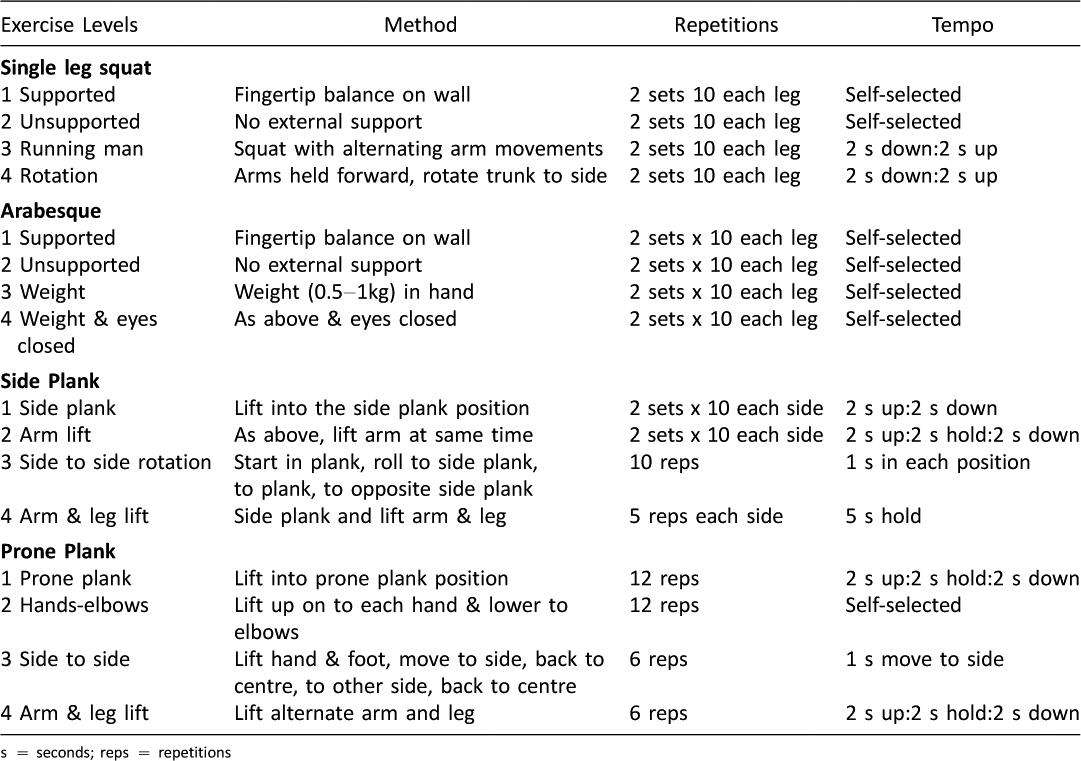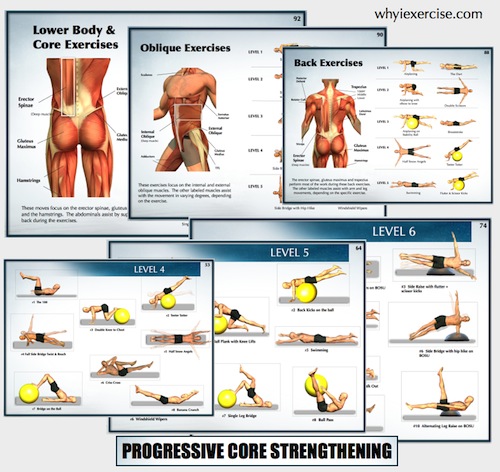Core Stability Training - Injury Performance Pdf
ABSTRACTIn recent years, fitness practitioners have increasingly recommended core stability exercises in sports conditioning programs. Greater core stability may benefit sports performance by providing a foundation for greater force production in the upper and lower extremities. Traditional resistance exercises have been modified to emphasize core stability. Such modifications have included performing exercises on unstable rather than stable surfaces, performing exercises while standing rather than seated, performing exercises with free weights rather than machines, and performing exercises unilaterally rather than bilaterally. Despite the popularity of core stability training, relatively little scientific research has been conducted to demonstrate the benefits for healthy athletes. Therefore, the purpose of this review was to critically examine core stability training and other issues related to this topic to determine useful applications for sports conditioning programs.
Based on the current literature, prescription of core stability exercises should vary based on the phase of training and the health status of the athlete. During preseason and in-season mesocycles, free weight exercises performed while standing on a stable surface are recommended for increases in core strength and power. Free weight exercises performed in this manner are specific to the core stability requirements of sports-related skills due to moderate levels of instability and high levels of force production. Conversely, during postseason and off-season mesocycles, Swiss ball exercises involving isometric muscle actions, small loads, and long tension times are recommended for increases in core endurance. Furthermore, balance board and stability disc exercises, performed in conjunction with plyometric exercises, are recommended to improve proprioceptive and reactive capabilities, which may reduce the likelihood of lower extremity injuries.
Core Training: Evidence Translating to Better Performance and Injury Prevention Stuart McGill, PhD Spine Biomechanics, Department of.
In recent years, fitness practitioners have increasingly recommended core stability exercises in sports conditioning programs. Greater core stability may benefit sports performance by providing a foundation for greater force production in the upper and lower extremities. Traditional resistance exercises have been modified to emphasize core stability.
Such modifications have included performing exercises on unstable rather than stable surfaces, performing exercises while standing rather than seated, performing exercises with free weights rather than machines, and performing exercises unilaterally rather than bilaterally. Despite the popularity of core stability training, relatively little scientific research has been conducted to demonstrate the benefits for healthy athletes. Therefore, the purpose of this review was to critically examine core stability training and other issues related to this topic to determine useful applications for sports conditioning programs. Based on the current literature, prescription of core stability exercises should vary based on the phase of training and the health status of the athlete. During preseason and in-season mesocycles, free weight exercises performed while standing on a stable surface are recommended for increases in core strength and power.
University Of Waterloo
Free weight exercises performed in this manner are specific to the core stability requirements of sports-related skills due to moderate levels of instability and high levels of force production. Conversely, during postseason and off-season mesocycles, Swiss ball exercises involving isometric muscle actions, small loads, and long tension times are recommended for increases in core endurance. Furthermore, balance board and stability disc exercises, performed in conjunction with plyometric exercises, are recommended to improve proprioceptive and reactive capabilities, which may reduce the likelihood of lower extremity injuries.
Address correspondence to Dr. Willardson, jmwillardson@eiu.edu. © 2007 National Strength and Conditioning Association.
Lumbo -pelvic stability, rehabilitation, stabilization. (6.3 MB) (in RefMan/RIS format) (;; ). Their theories were based mainly on studies dealing with low back pain pa tients. The arguments and recommendations from these studies were promptly accepted and adopted by the fitness industry ( ).


The early studies have been cited frequently, as they provide a point of departure for further investigations within the topic, and the importance of core stability on athletic performance and injury prevention has been heavily debated the last decade. Definitions of the term core stability vary across studies according to the context in which they are viewed. However, most authors generally incorporate the trunk into the core definition, with special emphasis on the lumbo-pelvic region of the body ( ). The stabilizing system consists of passive (ligaments and bones), active (muscles) and neural structures ( ). Do competitive, high-level athletes perform core training? If we look to scientific publications, the general training patterns of world-class performers in a broad range of sport disciplines have been described, including ice hockey ( ), rowing ( ), cross-country skiing (; ), biathlon ( ), speed skating ( ), soccer ( ), orienteering ( ) and Nordic Combined ( ). Unfortunately, these studies do not reveal to what extent core training has been performed, as core training was not quantified.
Injury Prevention
As conditioning experts and physiotherapists at the Norwegian Olympic Training Centre, the present authors have in-depth knowledge of daily training and rehabilitation programs for a large number of high-level performers. Our inspection of training sessions, training diaries and conversations with athletes and coaches) reveals that core training is performed by world-class athletes in cross-country skiing, biathlon, ski jumping, Nordic combined, speed skating, snowboard, alpine skiing, ice hockey, soccer, handball, rowing, kayak, swimming, cycling, golf, sailing, taekwondo, wrestling, orienteering and athletics. Indeed, core training is one of very few training forms common for all these sport disciplines. The total weekly core training volume varies considerably among.
News
- Club 3d Theatron Agrippa Dts 7.1 Drivers
- Norton Ghost 15 Full Cracked
- Visual Labels 3.57 Keygen
- Daemon Tools 64 Bit
- 7 Notti In Arena Ligabue Music
- Brooks And Dunn Cowboy Town Rar
- Rslogix 5000 V20 Activation Crack
- Driver Sony Lt28h
- Drama Korea My Name Is Kim Sam Soon Subtitle Indonesia
- Game Stick Figure Badminton
- Microsoft Frontpage 2003 (italiano)
- Load Pastel Crack File
- Hyperterminal For Windows Xp Professional
- Iggy Pop And The Stooges Ready To Die Rar
- Keygen Wiso Sparbuch 2013
- Wu Tang Indie Culture Lost Files
- New English File Ipacks